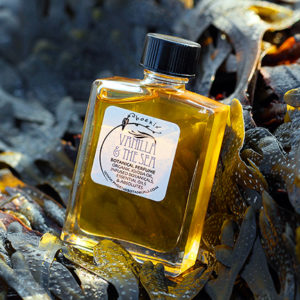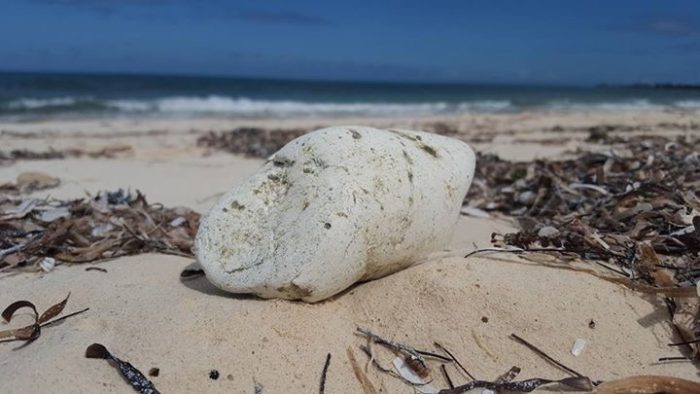
JK De Lapp of The Rising Phoenix Group Photo of Ambergris on the Beach Bahamas ©
Mysterious, otherworldly, smelling of the ocean and of life, stinky and ethereal, ambergris is legendary, and valued beyond gold. Never cultivated, only found, improving as it ages, and soaking in fragrances of sun, sea, and air, it is an aromatic like none other.
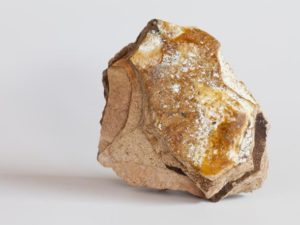
Photograph by David Liittschwager, National Geographic; collection of Mandy Aftel ©
Perfumer Mandy Aftel of Aftelier Perfumes describes the lure of the exotic ambergris in her book Fragrant: “The landscape of perfumery is rife with substances that trigger our sense of wonder, their origins so arcane as to seem mythic, with scents to match—funky, earthy, impossible to describe, at once attractive and repulsive. Perhaps the epitome of this world of wonders is ambergris, with its exotic origins in the digestive tract of sperm whales, and its surprisingly delicate, almost unearthly aroma.”
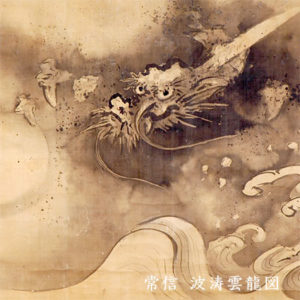
Artist Kano Tsunenobu, Dragon Painting
To describe ambergris, we need to talk about its origin, which remained a mystery for centuries. There were a number of theories: perhaps it was a blend of labdanum, aloe-wood, and civet; the dried foam of seals; the excrement of a sea bird that lived on sweet herbs; the product of some kind of undersea fountain; a mixture of beeswax and honey from shore-dwelling bees; or perhaps a truffle growing at the bottom of the sea. Or my favorite, Chinese legend tells of dragons sleeping on rocks that drool ambergris into the ocean.

The Whalers Joseph Mallord William Turner
Sadly, it was the whale-fishing industry that provided answers, helping us to understand that ambergris originates in the digestive tract of whales. A specific whale, the sperm whale (Physeter macrocephalus) and sometimes the pygmy sperm whale (Kogia breviceps) are the only known source for ambergris. Whalers found an icky black substance, recognized as crude ambergris, in the intestines of whales they caught. This clearly pointed to a digestive tract origin but the question remained…from which end. Is it vomit or feces? Those who have smelled the fresh stuff clearly vote for the ‘poo’ theory. Others subscribe to a front end origin or the ‘whale vomit’ concept. The reality is that, while not technically feces, ambergris is a product of the lower intestine and it comes out smelly and stinky.
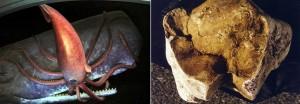
Master Perfumer Maurice Roucel of Symrise wrote in his January 1, 2011 interview with Michelyn (about IFRA regulations) on Ambergris, “It is a stupidity to forbid this material. Because you actually protect the Sperm Whale, by using it. Nothing in the world smells this disgusting. It’s black and liquid, you have never seen anything so vile. But after year after year, the sun, wind and ocean transforms it into a solid like bleached stone. The smell now is gorgeous”.

Both the stinky black mass and beautifully cured silvery ambergris contain the sharp beaks of cuttlefish, a primary prey item of the sperm whales. These beaks are indigestible, potentially irritating, and mostly likely regurgitated in 99% of whales without damage. For the unlucky 1%, the beaks remain in the digestive system and are coated with layers of a waxy substance called ambreine. Scientists don’t know whether this blob of waxes, aromatic chemicals, and squid beaks makes it way out with the feces in some cases or whether its immutable destiny is to remain within the whale, growing larger and ‘aging’ in the lower digestive tract. These impactions become pathological and eventually cause a rupture, killing the whale and releasing the waxy mass of ambergris into the sea.
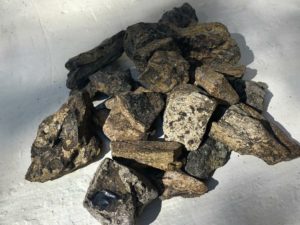
JK De Lapp of The Rising Phoenix Group Photo of Grey Ambergris
This, then, is where the magic occurs. Lumpy, dark, fecal, and unattractive, the waxy and fatty ambergris floats on the ocean. Sun, salt air, and time continue the conversion of ambreine and other scented and unscented molecules into the indescribable treasure that is ambergris. As the darkness fades into grey, a silvery sheen appears on the rounded mass of ambergris, cuttlefish beaks still firmly embedded, and the fragrance blooms.
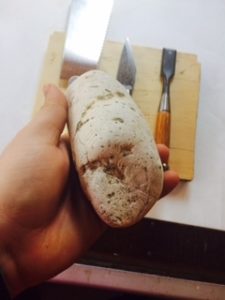
JK De Lapp of The Rising Phoenix Group holding 100 yr old ambergris ©
Called ‘floating gold’ it is found on beaches throughout the world and a quick search online will find stories of ambergris finds in the tens of thousands of dollars, often involving a dog sniffing out the smelly stuff. Ambergris in the wild looks like nothing more than a slightly rough rock, bringing to mind the meaning of its name, ambergris, or grey amber.
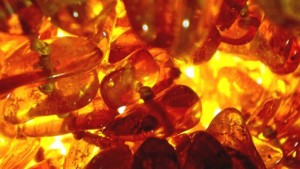
Amber resin stones
The name amber is famously confusing (see my post on amber) and generally refers to the yellow-gold gemstone which is smooth to the touch and may contain insects while ambra may be shorthand for ambergris. National Geographic writes that a British boy and his Dad found a chunk of ambergris weighing in at 1 lb worth $63,0000) and when used in perfumery can be thousands of dollars an ounce. Ambegris is rare, even illegal in some countries. Ambergris adds tenacity, radiance, sillage, lift, marine and woody notes, and a very special beauty to perfumes.
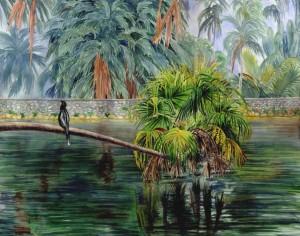
Lagoon in Fairchild Gardens
Natural Perfumer Anya McCoy of Anya’s Garden has this to say about ambergris: “I first started using ambergris in 2002, and I still have some of that vintage tincture. In 2006, I released my first perfume containing ambergris, Fairchild. It’s a Floral Marine Chypre, and the ambergris melded the seaweed and choya nakh to the florals in a seamless, slightly salty way.”
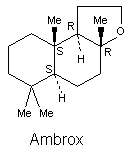
Due to legal constraints, rarity, and expense, replacements have been highly sought after. In order to recreate important odor components of ambergris, fragrance chemists went to clary sage, cistus/labdanum, and balsam fir. Reconstructions vary in their intensity, woodiness, ambery quality, and longevity, and they take advantage of a certain similarity in odor profiles to create, for example, AMBROX© from clary sage which, depending on form, may be warm and animalic, or woody. There are at least ten single molecule replacements by my count with slightly different effects. There are also ambergris bases that replicate the tincture, usually proprietary blends from fragrance houses. Thankfully, I was able to turn to two talented perfumers for their help with synthetic ambergris replacements.

Pierre-Constantin Guéros Symrise
Pierre Guéros, Perfumer at Symrise, reminds us that “There are a lot of ‘ambery’ notes, that could go from vibrant ambery woody notes (very popular right now especially in masculine fragrances, like AMBROCENIDE©, NORLIMBANOL©, AMBERMAX© or KARANAL©, to woody, smoky leather ambery notes (derivates from cistus/labdanum like ambrein or hydrocarboresin) and finally the classical ambery – Guerlinade accord (coumarine, vanillin, cistus once again).” He further states that AMBRINOL© (AMBRINOL S© from Symrise) is a key substitute for the ambergris tincture with its marine and animalic note”.

Rodrigo Flores-Roux SR VP of Givaudan-Fine Fragrance
In a phone conversation Rodrigo Flores-Roux, Vice President of Perfumery at Givaudan, used his deep knowledge of the art to help me to understand the complexity of ambergris. He first pointed out that perfumers have many points of recognition when they smell ambergris—some may get the animalic note, some tobacco, some iodine, and some the woody aspect; the descriptor ‘elephant-like’ seems to come up with some frequency as well. He further states that the perfume industry has approached the amber chemical with relish, creating a lot of ambergris replacements. These include AMBERMAX©, which he describes as a ‘driving, piercing, elegant dry wood note’ that is apparent throughout the evolution of the perfume.
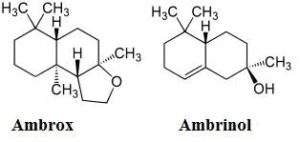
Ambrox© and Ambrinol© are used to capture the smell of real ambergris
AMBROCENIDE© also goes through from top to bottom like ‘an elegant shimmering dagger.’ Then there is AMBER EXTREME© from IFF that pulsates in the center of the perfume and helps fill in for woody notes. For natural replacements, he likes to look at the effect of clary sage with woody materials but also recognizes the very clear tobacco association. Perhaps also tiny amounts of everlasting and other animalic or patchoulic ingredients.

Waiting for The Light David Jay Spiker ©
The magic of time and sea takes ambergris that is animalic and fecal, rounds and softens the edges, putting them in the background and adds the beauty of the sea and the sun. Iconic ambergris brings seaweed, fine woods, tobacco, incense, clary sage, musk, oceans and waters, radiant florals, salt, amber, and wine together in one mysterious and humble package.
–Elise Pearlstine, Editor and Perfumer for Tambela
Art Direction: Michelyn Camen, Editor in Chief, Special thanks to Pierre Gueros and Rodrigo Flores-Roux for their insights especially into the synthetics used to capture “ambergris” and to JK for the amazing photos of real beach found ambergris.
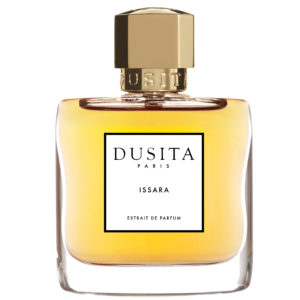
WORLDWIDE: Parfums Dusita Issara (Pissara Umavijani) A fresh fougere 50ml Parfum Extrait beach found Ambergris
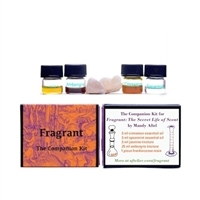
WORLDWIDE: Aftelier Fragrances Fragrant Companion Kit containing Ambergris tincture All Natural (Mandy Aftel)
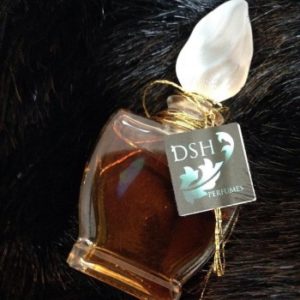
WORLDWIDE: DSH Perfumes “Animalic, sexy and salty Rendez Vous” mini flask Eau de Parfum (Dawn Spencer-Hurwitz)photo does not represent a mini flask
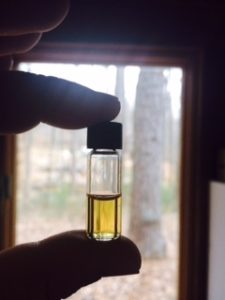
WORLDWIDE: The Rising Phoenix Group a mini vial of Silver / White Ambergris Tincture @10%Procured from the Indian Ocean Aging since 2011(J.K.DeLapp) All-Natural
WORLDWIDE: Phoenix Botanicals Vanilla & The Sea –All Natural 5 ml (Irina Adam) Inspired by Winter Walks on the beach

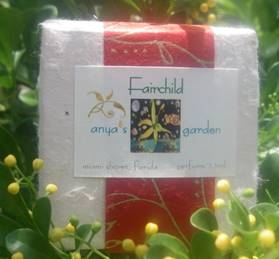
USA ONLY: Anya’s Garden Fairchild –All Natural 4ml (Anya McCoy) Floral-Marine-Chypre
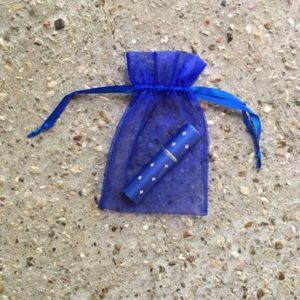
USA ONLY: JoAnne Bassett Opulence Eau de Parfum 5 ml travel sprayer. Opulence has vintage ambergris tinctured in organic grape alcohol.
To be eligible for our Ambergris in perfumery draw, please be sure to register if you have not done so. Also your choices must include at least one Indie and one all-natural ambergris perfume (note all ambergris perfumes above contain real ambergris). You must be registered and you must use your user name or your entry is invalid. Please leave a comment with what you learned about Ambergris in perfumery along with your choices, and where you live. Draw closes 3/12/2016
We announce the winners on our site and on our Facebook page, so Like Cafleurebon and use our RSS feed…or your dream prize will be just spilled perfume

